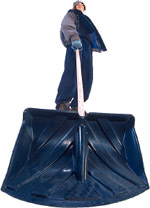Locations

Fax: (303) 762-9292

In The Bleak Mid-winter: 10 Tips for Safe Snow Shoveling

With winter now upon us, and snow covering many regions of the United States, millions of people are shoveling snow to clear their sidewalks and driveways. While most people recognize that snow shoveling is very hard work, and can put severe stress on your heart, fewer people recognize the stress and strain that it places on your back. So, as winter gets underway, we've outlined 10 tips for how to keep your back healthy when shoveling snow.
The Problem
Snow shoveling can place excessive stress on spinal structures. These stresses are a common cause of low back strains and vertebral disc damage
In a study published by Dr. Brad Coffiner, the author noted "when handling heavy snow with a shovel, the L5/S1 disc (i.e. the low back) has been identified as the weakest link in the body segment chain. The most severe injuries and pain are likely to occur in this low back region."
Tips for Safe Snow Shoveling
Having recognized that snow shoveling can injure your back, now lets look at tips to help you avoid such problems.
- Tip # 1.
If you experience pain of any kind, stop immediately and seek assistance. - Tip # 2.
Choose a snow shovel that is right for you!- Be sure that your shovel has a curved handle, as this enables you to keep your back straighter when shoveling.
- Obtain a shovel with an appropriate length handle. The length is correct when you can slightly bend your knees, flex your back 10 degrees or less, and hold the shovel comfortably in your hands at the start of the "shoveling stroke".
- A plastic shovel blade will generally be lighter than a metal one, thus putting less strain on your spine.
- Sometimes, a smaller blade is better than a larger blade. Although a small blade can't shovel as much, it avoids the risk of trying to pick up a too heavy pile of snow with a larger blade.
- Tip # 3.
Push the snow, do not lift it. Pushing puts far less strain on the spine than lifting. - Tip # 4.
Be sure your muscles are warm before you start shoveling. Cold, tight muscles are more likely to sprain or strain than warm, relaxed muscles. - Tip # 5.
When you grip the shovel, make sure your hands are at least 12 inches apart. By creating distance between your hands, you increase your leverage and reduce the strain on your body. - Tip # 6.
Your shoveling technique is very important. The American Academy of Orthopaedic Surgeons recommends: "If you must lift the snow, lift it properly. Squat with your legs apart, knees bent and back straight. Lift with your legs. Do not bend at the waist. Scoop small amounts of snow into the shovel and walk to where you want to dump it. Holding a shovel of snow with your arms outstretched puts too much weight on your spine. Never remove deep snow all at once; do it piecemeal. Shovel and inch or two; then take another inch off. Rest and repeat if necessary." In addition to these comments, remember to move your feet rather than twisting. - Tip # 7.
Never throw snow over your shoulder. - Tip # 8.
Remember that wet snow can be very heavy. One full shovel load can weigh as much as 25 pounds. - Tip # 9.
Pace yourself by taking frequent breaks to gently stretch your back, arms and legs. - Tip #10.
Consider buying a snow-blower. When used correctly, a snow-blower will put far less strain on your back than snow shoveling.
By following these tips, you are far less likely to be injured while shoveling snow.
Finally, for those of us who are able bodied, it is always worth remembering neighbors on your block who might not be able to remove the snow from their sidewalks. A few minutes of help can make the world of difference to the well being of a less able bodied person as well as make you a good neighbor!








